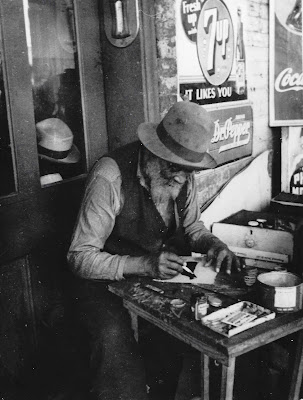Bill Traylor, the subject of the new documentary BILL TRAYLOR: CHASING GHOSTS, was already 86 years old back in 1941, the year that TrustMovies, the fellow who is writing this review, was born. Mr. Traylor himself was born in Alabama as a slave in 1853 (that's how far back this doc goes), and yet his art -- however you might describe it: "outsider" "folk" or "primitive" -- also resonates as surprisingly contemporary, if also somewhat befuddling. Traylor's story, however -- his history, his life and his art career -- resonates without a bit of that befuddlement.
The film's director, Jeffrey Wolf (shown at left), and its writer, Fred Barron, have put together in a mere 75 minutes, a movie that offers us as fine an example, via the life and work of a single individual, of the Black experience here in the USA as any I've seen.Bill Traylor: Chasing Ghosts is primarily about this man's art, which has, since the late 1970s and early 1980s, been recognized by the art establishment as significant. (MOMA, ever the sleazy institution, actually tried, via its then director, to purchase a chunk of Traylor's art in the early 1940s at a ridiculously low price.)
We view plenty of this art (shown above and below) during the course of the film -- enough, actually, to be able to form our own conclusions about it. For me, the art is fascinating in its simplicity, even if its meaning proves more elusive than anything else. Instead, it is the life of this man -- as a slave who was greatly appreciated by his original "owner," so much so that that owner, the head of the "white" Traylor family, made certain that the further care of the black Traylor family was provided for in his will -- that resonates most strongly.
As one of the many highly intelligent and thoughtful narrators points out early on, as horrible as slavery was, "it had plenty of 'gray' areas, rather than always being, no pun intended, something black and white." These black and white Traylors were one such instance, as Bill Traylor and his family continued to work for the white Traylors for 40 years after slavery had been abolished -- and only left, once the white family was taken over by a particularly unjust Traylor offspring.
We see how Traylor's art came about, and how the man (shown above and below) -- quite the womanizer -- came to sire perhaps 20 offspring, all of whom he managed to care for as well as he could, while living and working during slavery, reconstruction, the Jim Crow south and beyond.
Once we meet the generations that came after him, while seeing and understanding how his art slowly accrued its reputation, we're simply amazed and ever more appreciative of his accomplishments. Bill Traylor: Casing Ghosts turns out to be a wonderful memorial to a man, his art and to a time long gone that has now been returned to us via this unusual and remarkable movie.
From Kino Lorber and running 75 minutes, the documentary opens tomorrow, Friday, April 16, in New York City at Film Forum, and the in Los Angeles area at Laemmle theaters, as well as elsewhere around the country. Click here and scroll down to view all currently scheduled playdates, cities and theatres (virtual or otherwise).











No comments:
Post a Comment